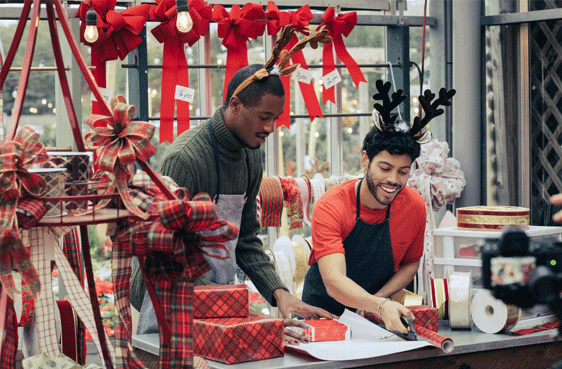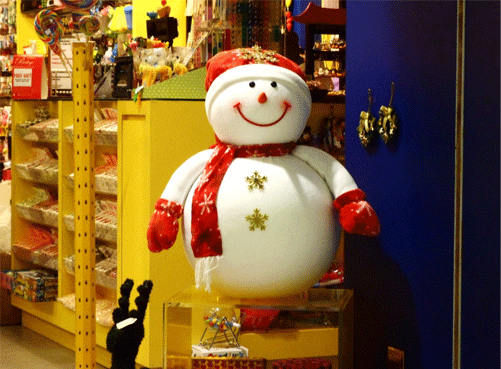The holiday season is one of the most important sales periods and opportunities for brands and retailers. According to data released by the National Retail Federation (NRF) earlier this year, retail sales are expected to grow between 4% and 6% and will reach between $5.13 trillion and $5.23 trillion this year.
Even though the holidays present an exciting opportunity for retailers to make up for any slow months throughout the year, inflation, unemployment and a higher cost of living are all situations that many consumers are dealing with. This means brands will not be able to simply get by with minimal marketing efforts. As the competition continues to increase and more shoppers are looking to stretch their dollar, retailers need to step up their game.
The holiday season is a time of joy and giving, and for consumers, it’s also a time of elevated expectations when it comes to their shopping experience. Understanding consumers’ expectations for holiday shopping both online and in store will allow retailers and ecommerce companies to meet and exceed these demands to ensure a great customer experience.
Specialty Retailer has created the Ultimate Holiday Prep Guide for indie brands to give insight into what customers are looking for and how you can hit your sales mark. No matter what your marketing budget looks like, we have experts offering advice from all over the playing field.
Gift Card Programs
Each holiday season, Blackhawk Network (BHN) runs proprietary consumer research to forecast trends to help brands and merchants prepare. BHN’s 2023 holiday research found that consumers plan to spend $770 on holiday gifting this year, which is a 3% increase over last year. Of their total gifting budget, shoppers plan to spend 43% on gift cards. That’s a whopping 21% increase YOY.
According to Brett Narlinger, head of global commerce at BHN, gift card programs can be a low maintenance, affordable and effective way for smaller retailers to compete against larger stores while also helping acquire new customers and encourage foot traffic to stores. And, with Gen Z driving shifts in holiday shopping trends this year, it can be an effective approach to capturing younger consumers. Gen Z consumers report they plan to spend 56% more on gift cards this holiday season than they did last year.
Curate Your Holiday Product Assortments
“Impactful holiday strategies start with curated holiday product assortments, localization and personalization, which smaller retailers and family-owned businesses are well positioned to use to their advantage,” Rae Guimond, Strategy & Business Development Director of PriceSpider, says. “Retailers and brands that stand out the most during the holidays offer distinctive holiday selections that set them apart from competitors.”
From beer to chocolate, food and beverage brands like Coca-Cola, Hershey’s and Starbucks are well known for their holiday packaging and flavors. Health and beauty brands have also increased holiday packaging and limited-time products in recent years, according to Guimond, from everything from eyeshadow palettes to bath fizzes. Even the deodorant brands have engaged in holiday-inspired marketing and gifting such as Native (Candy Cane), Schmidt’s (Snow Day) and Old Spice’s holiday gift sets featuring body wash, shampoo and deodorant.
Agreeing with Guimond is Jay Myers, Co-founder of Bold Commerce. Between Black Friday, Cyber Monday and holiday shopping, consumers are looking to purchase gifts for their loved ones, but marketing efforts are not always packaged that way.
According to NRF data, consumers spent an average of $325.44 on holiday-related purchases over the course of Cyber Week, up 8% from $301.27 in 2021. Seventy percent of the average 2022 Cyber Week spend in the U.S. was directed specifically towards gifts.
“If you think about the emails that are sent out on Thursday night about how ‘Black Friday Sales Begin Now,’ what the customer actually wants is to shop for gifts, so package your emails in the form of a gift. Even messaging such as ‘Our Biggest Holiday Gift Giving Event Starts now,’ or maybe changing your website to add categories for her or him. That’s what consumers are going to websites to look for. But many stores just promote the sales, which yes, customers are coming for deals, but they are also coming to look for gifts,” Myers says.

Start Planning Early
Chris Gerbig, Co-founder and CEO of Pink Lily, explains that he orders their inventory, creates the marketing plan and shoots the pictures/videos/ads months before the holidays. “This allows us to hit the ground running when the season arrives and there are no last-minute surprises that could impact sales.”
Black Friday has become so incredibly competitive from a retail perspective, that Gerbig has found it helpful to start Pink Lily’s holiday sales before the major shopping weekend. The competition is lighter and consumers are still in the shopping mood. Some retailers even have a Black Friday month of sales during November.
In order to remain competitive, Matt Hopkins, Global Retail Director and specialist in AI strategy for merchandising and supply chain at Board International, says retailers need to focus on these three key aspects of their holiday planning and execution:
- Scenario planning. Avoid developing your holiday sales bottom up. This can introduce a lot of assumptions and inaccuracy, especially if you’re using last year’s sales. Look at using scenarios to tightly couple profitability with demand across assortments and channels.
- Demand planning. Build consensus across supply chain, merchandising and operations with a single view of demand and profitability.
- Demand sensing. When you hit the holiday sales, look at ways to adapt faster to sales as it happens by using real-time demand signals. This will help to inform better allocation, replenishment and markdown decisions.
Another way retailers can plan early for the holidays is by stocking up on inventory. “Black Friday tends to be a better sales day overall, so it is best to get inventory ramped up ahead of schedule to have enough product for shoppers to purchase,” Michael Allmond, Co-founder and VP of Lover’s Lane, advises. “Because we sell both online and in-store, it is important for us to keep our warehouse stocked for Cyber Monday directly after Black Friday. We usually increase inventory on our best-selling products or hot sale items at least two weeks prior to the big weekend.”
Utilize AI for Peak Season Preparations
Lisa Henriott, SVP, Product Marketing, Logility, says that constant shifts in consumer behavior and rising demands for delivery speed and personalization complicate forecasting and inventory planning for retailers. By leveraging the power of AI, specialty retailers can see the direct impact of demand levers like promotions and consider more external demand drivers, like social sentiments or weather, than ever before.
“Specialty retailers must address the need to make fast, accurate, data-driven decisions to drive efficiency and minimize costs in the supply chain. AI-first planning solutions quickly digitize massive amounts of data, optimize the options, and expose the plan to decision makers at all levels of the organization,” Henriott says.

Create Exciting In-Store Experiences
Jaime Bettencourt, SVP of Brand Marketing at Mood Media, says small retailers can best prepare for the holidays by creating lasting on-premise encounters with sensory catalysts. A resounding 90% of global consumers are more inclined to revisit establishments harnessing these stimuli. Customers feel welcomed and valued through experiences, inspiring them to return for more.
Bettencourt offers some different stimuli retailers can offer in their stores:
- Music. Get customers amped to shop in your store with some upbeat music. According to Mood Media stats, contemporary pop is the most popular music genre for businesses.
- Fragrances. During the holidays, Bettencourt sees a lot of requests for fragrances in stores to get shoppers in the holiday mood.
- Digital Displays. Even if they’re not digital, having interactive displays around your store can encourage customers to make a purchase or even make a connection with your brand. Place a QR code sign near certain products so customers can learn more or see how the item is made.
Mobile Shopping Reigns Supreme
Mobile preference statistics state that 71% of consumers plan on using their mobile phone to shop during the Black Friday/Cyber Monday weekend this year. Fewer people plan to shop using a computer, dropping from 59% in 2022 to 57% in 2023. Mobile shopping apps was the only channel that saw an increase in popularity this year—up 3 points from 65% in 2022 to 68% in 2023.
“COVID is gone, everyone is remote, and people are not at home on their laptop. They’re on the beach, climbing a mountain or in the club where they want everything to happen with a double-tap. Test your store, optimize all your ads, funnels and upsell journeys for every possible device and you might just make it,” Mike Savoff, Shopify market Strategist at Rush.app, says.
Myers agrees with Savoff, saying that retailers need to make sure their apps are in tip top shape and that their website can easily work on a mobile phone.
“If you’re doing mockup pages or redesigning, it has to be mobile first,” Myers advises. “I would say that all year long, but especially for the Black Friday/Cyber Monday weekend. The biggest value and sales will be up over that weekend, but the biggest value as a brand is getting customers to become long-term shoppers.”
While working on your apps or mobile-friendly websites, Mario Matulich, President and Founder of CMP Research advises retailers to keep a frictionless experience in mind. “A frictionless experience is a brands ability to deliver as outlined and without issue. While related to speed, it has more to do with accuracy and convenience. The effort of the customer should remain low. If your customers have to work to buy from you, there is a strong chance they will only be buying once. The brands that understand their customer’s journey and remove barriers and high effort moments will be in line for increased market share.”

Offer the Right Deals and Promotions
Savoff suggests that personalized bundles are where the money is at. Especially with all the promotions that customers will see everywhere, it’s much easier to get everything they need in one place instead of several stores. Offering personalized bundles where shoppers can add the exact items or variants they want to their bundle will surely give merchants higher sales volume.
Other deals to focus on are ones that bring customers back to your store. This can be done through abandoned cart offers and post-purchase upsells.
“If you haven’t automated SMS automations for abandoned carts in 2023, you’re far behind the curve. As for upsells, they can be some of the best deals when you place them at the right touchpoints in the post-purchase journey – after checkout and along your order tracking page and emails. People who already purchased visit the tracking page an average of three times until their order is delivered. Each visit is an opportunity to upsell an exclusive deal,” Savoff adds.
No matter what your holiday planning looks like, all of our experts say everything comes down to customer loyalty. You can offer all the best deals, products and in-store shopping experiences, but if you can’t figure out a way to turn one-time shoppers into repeat customers, you will not be successful.
Keep this in mind as you use our tips to prepare for the holiday season.




